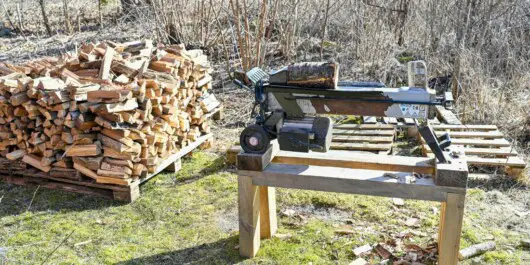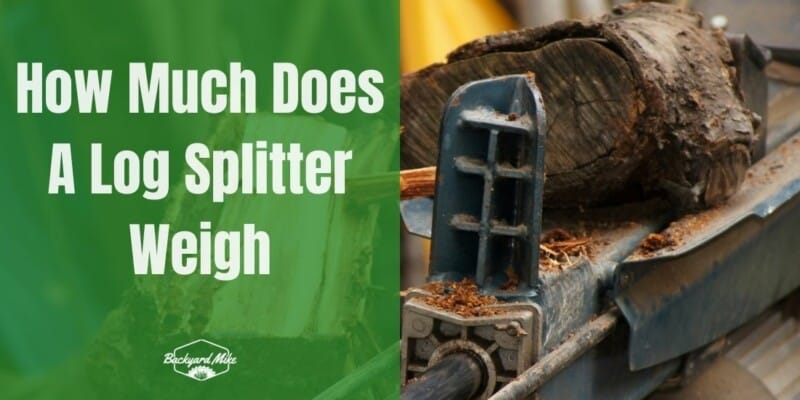Are you in the market for a new log splitter, but first you want to know how much does it weigh? If so, then you’re in the right place at the right time.
A log splitter weighs anywhere between 4 ton to 35 ton or more depending on the capacity of the log splitter. The more the capacity of your log splitter, the more will be its weight. If you’re going to cut logs that weigh on the higher side of the scale, you’ll need to go for a heavy log splitter. You don’t have to purchase a log splitter that is underpowered for your needs and fails to split the wood. However, there is no point in purchasing the most log splitter you find either.
In this article, you will get to know all about the weight of log splitters, how much does a log splitter weigh, how much capacity do you need in a log splitter, tips to tow a heavy log splitter, what size log splitter do you need, and more. Continue reading to get all the answers that you are looking for.
How much does a log splitter weigh?
If you’re a homeowner with a backyard, there’s nothing more satisfying than going outside with a nice log splitter and powering your way through a stack of logs to get a pile of firewood. It’s a great therapy and exercise that you can do. In fact, chop your own wood once, and it’ll warm you twice.
The romantic notion aside, you cannot beat a log splitter when you need to split logs quickly without too much sweat and effort. Lately, there has been an increase in the purchase of log splitters as the price of firewood has increased. Either homeowners are keen to be more self-sufficient or they’re looking to make life easier for themselves.
Log splitters are rated by the weight or hydraulic ram’s tonnage. The greater the force produced, the tougher and larger the log you’ll be able to split. There are also some secondary design features such as the length and diameter of the log that the log splitter could handle, but the primary issue is force.
You shouldn’t be buying a log splitter that is smaller, lighter, and underpowered for your needs and isn’t able to split the logs that you have. However, there is no point in purchasing the heaviest and most powerful splitter you’re able to get your hands on either. As the power increases, so will the splitter’s size, weight, and sturdiness. If all that you’re doing is splitting logs and a bit of pine, a 40-ton diesel-powered machine that you’ve bought will be a waste of money, while it’ll also take up unnecessary room.
The telling point is that the most commonly rented log splitter in the United States is the one rated at 26 tons. Unless you’re producing firewood, or you’ve got huge diameter logs, it is unlikely that you will require a higher rating than that. In case logs are 24-inches or more in diameter, you may consider a 27-ton or 30-ton log splitter.
For 6-inch logs, you will probably require 6 to 10-ton log splitters. 12-inch logs will require 12 to 22-ton, while 18-inch logs will require 20 to 26-ton log splitters. If the timber is hard, you need to go to the upper end of this range, but you’ll be able to save yourself money and pick a splitter at the bottom of the range if it is soft.

What is the best log splitter to buy?
The best log splitter for a homeowner might not be the best one for another. Depending on the type of log you’re cutting, you’ll have to choose the weight of the log splitter. There are numerous factors that go into making your decision. It shouldn’t just get the job done, but it should also do so while ensuring you’re not wasting money. It is recommended that you should go for a log splitter in the 25-ton range.
1. Not all logs are equal
The first thing you’ll need to remember about choosing the right log splitter is that not all logs are equal. Some of the wood that you get is properly seasoned, dry, and rather easy to split, similar to a hot knife through butter. Some of the wood you’re going to be cutting might not be as easy to split.
Some wood is tough to split. Some cords that you order from firewood vendors also contain oversized, knotty, damp, or stringy logs. This is one of the biggest advantages of going for a log splitter with appropriate weight. A proper log splitter that has the right weight, ample splitting force, and a short cycle time will make the splitting much simpler.
2. Aim to go for more splitting force
It’ll be better to have a bit more splitting force than too little, especially if you’re not willing to spend the weekend unjamming the half-split wood from your log splitter’s edge.
A 25-ton log splitter will be enough for you in most cases. However, if you have to split many logs per season, then you can go for a heftier, 40-ton log splitter.
3. Dense wood will require more power
You should consider the type of wood that you’re splitting. If you prefer dense wood like maple, walnut, oak, birch, or locust, then you will benefit from the increased splitting force of the 40-ton log splitter.
The primary downside to the larger capacity log splitters is that they’ve got higher fuel requirements, they’re much more expensive, and they’re relatively heavier. These log splitters will save you stress and frustration if you have to split lots of wood.
Tips on towing heavy log splitters
If you’ve purchased a log splitter that is on the heavier side, and you have to tow it or move it, things can get slightly tricky. Some log splitters come with couplers for attaching to your trailer hitch ball, safety chains, and thick pneumatic tires. You should be careful when you’re towing your log splitter. Here are some of the topics to keep in mind when towing or moving heavy log splitters –
- Turn the fuel shut valve in the “OFF” position, and otherwise you might end up flooding your log splitter’s engine
- Ensure that the log splitter is empty when you’re securing it to your vehicle and when towing
- Remember to attach safety chains to your vehicle’s hitch or bumper
- Before starting your vehicle, you should double-check the log splitter to make sure that it is securely chained to your vehicle
- Never exceed 45 MPH when you’re towing the log splitter
- When you’re driving, pay attention to avoid hilly terrain, sharp turns, and steep angles
- Recheck the log splitter’s towing connection and coupler every 50-60 miles of driving
- When you’re driving, parking, or crossing intersections, remember to compensate for the added size of the log splitter
What size log splitter do you need?
It can be a slightly difficult question to answer. Sometimes, what you want out of your log splitter and need from your log splitter are two entirely different things. At times, you don’t really need that much tonnage unless you have a lot of wood to split frequently.
Most homeowners just do not require as much weight and force, consistently, for most of their splitting projects. With that said, it’s also fair to admit that in certain situations it’ll make sense to go for a heavier and larger log splitter if you’ve already narrowed down your choices. It should be worth noting that the average rental size unit in the USA is a 26-ton log splitter, as most non-commercial projects just don’t require more tonnage than that.
Conclusion
Thank you for reading. Hopefully, now you know a lot more about the weight of log splitters, how much does a log splitter weigh, how much capacity do you need in a log splitter, tips to tow a heavy log splitter, what size log splitter do you need, and more.
A log splitter weighs anywhere between 4 ton to 35 ton or more depending on the capacity of the log splitter. The more the capacity of your log splitter, the more will be its weight. If you’re going to cut logs that weigh on the higher side of the scale, you’ll need to go for a heavy log splitter. You don’t have to purchase a log splitter that is underpowered for your needs and fails to split the wood. However, there is no point in purchasing the most log splitter you find either.


